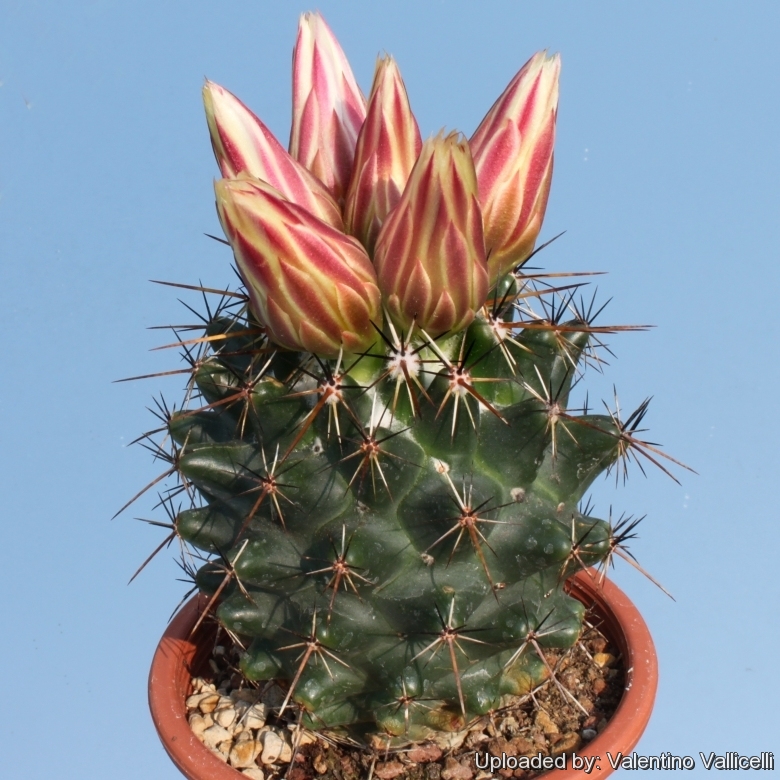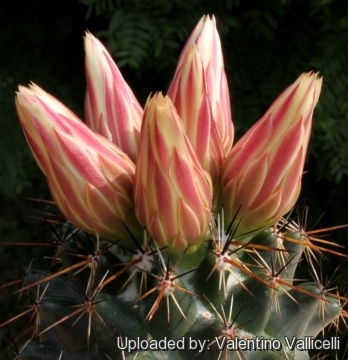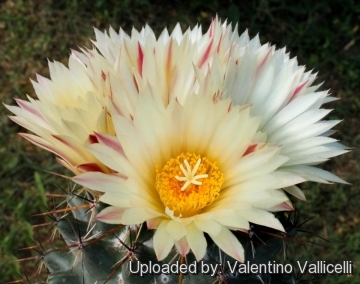Accepted Scientific Name: Coryphantha ottonis (Pfeiff.) Lem.
Cactées 34. 1868

Aulacothele ottonis (Coryphantha ottonis) Photo by: Valentino Vallicelli
Origin and Habitat: Central Mexico (Zacatecas, San Luis Potosi, Aguascalientes, Puebla, Tlaxcala, Hidalgo, Queretaro, Guanajuato, Jalisco, Mexico and Durango)
Type locality: Mineral del Monte, Mexico
Habitat: It grows on flat lava fields among rougher rocks, sometimes protected between bushes.
Synonyms:
See all synonyms of Coryphantha ottonis
back
Accepted name in llifle Database:Coryphantha ottonis (Pfeiff.) Lem.Cactées 34. 1868Synonymy: 19
back
Common Names include:
ENGLISH: Indian Head
Description: Coryphantha ottonisSN|735]]SN|735]] is a spherical solitary cactus that shows a wide range of distribution. It forms a complex of several species and varieties that most authors choose to lump them together. However, the transition between the forms is continuous and it is not easy to separate one to another, moreover the main characteristics of all these taxa, growth form, tubercle size and form, number of radial spines, flowers, fruits and seeds are all almost identical, as are the extrafloral nectary glands.
Stem: Simple, globular to short cylindric as it grows, apex woolly somewhat depressed, 12 cm high or less, 4-8 cm in diameter, succulent, glossy dark green, glaucous to greyish green.
Tubercles: Bluntly conical, in 5 and 8 series, soft, 10-15 mm long, 18 mm wide, completely grooved with, axils of flowering tubercles densely woolly with red glands.
Areoles: Round up to 3 mm broad, at first woolly then nacked.
Radial spines: 8 to 12, radiating, appressed, straight, needle-like, yellow to reddish, tip brown, later grey, nearly equal or the upper ones somewhat thinner, 8 to 12 mm long.
Central spines: 1 to 4, grey, yellowish, or reddish, longer and a little stouter than the radials, 15-20 mm long, sometimes hooked on young plants, straight, subulate, on older ones.
Blooming Habits: Flowers white, yellow, pale pink, or bright rose pink 4-5 cm long, 4-6,5 cm in diameter; outer perianth segments oblong, obtuse; Inner perianth segments apiculate. Filaments yellow, anthers saffron-yellow, stigma lobes 10, green, cylindrical, erect, yellow.
Blooming season: Flowers come freely between spring and fall.
Fruit: Small, roundish, up to 15 mm long, 10 mm wide green and juicy.
Seeds: Reniform, 1,6x0,8 mm broad, brown.
Bibliography: Major references and further lectures
1) Dr. med. Reto F. Dicht, Adrian D. Lüthy “Coryphantha: Cacti of Mexico and Southern USA” Springer, 2005 ISBN: 978-3-540-22306-1
2) Nathaniel Lord Britton, Joseph Nelson Rose “Cactaceae: Descriptions and Illustrations of Plants of the Cactus Family” Courier Dover Publications, 1963
3) Edward Anderson “The Cactus family” Timber Press, Incorporated, 2001
4) James Cullen, Sabina G. Knees, H. Suzanne Cubey "The European Garden Flora Flowering Plants: A Manual for the Identification of Plants Cultivated in Europe, Both Out-of-Doors and Under Glass" Cambridge University Press, 11/Aug/2011
5) David R Hunt; Nigel P Taylor; Graham Charles; International Cactaceae Systematics Group. "The New Cactus Lexicon" dh books, 2006
 Aulacothele ottonis (Coryphantha ottonis) Photo by: Valentino Vallicelli
Aulacothele ottonis (Coryphantha ottonis) Photo by: Valentino Vallicelli Aulacothele ottonis (Coryphantha ottonis) Photo by: Valentino Vallicelli
Aulacothele ottonis (Coryphantha ottonis) Photo by: Valentino VallicelliCultivation and Propagation: It is a summer-growing species of easy cultivation. It is sensitive to overwatering (rot prone) and slow-growing.
Soil: Grow it in an open sandy-gritty cactus compost.
Pots: It needs a relatively shallow pot to accommodate its fibrous roots and provide a very good drainage. They may stay in the same pot for many years.
Watering: Water in moderation, it prefer a completely dry place during winter. Mature individuals easily rot and die especially after planting so be extremely cautious with watering. Keep dry in winter or when night temperatures remain below 10° C. Water it less than average if in bigger pots.
Special need: Provide very good ventilation. Nearly all problems occur as a result of overwatering and poor ventilation, especially when weather conditions are dull and cool or very humid.
Fertilization: Feed them once during the growing season with a fertilizer specifically formulated for cactus and succulents (high potash fertilizer with a dilute low nitrogen), including all micro nutrients and trace elements diluted to ½ the strength recommended on the label. They thrive in poor soils and need a limited supplies of fertilizer to avoid the plants developing excess vegetation, which is easily attacked by fungal diseases.
Exposure: It will do its best with lots of sun and become stressed with inadequate light which could result in poor growth and unnatural shape.
Hardiness: It likes warmth (recommended minimum winter temperature 5° C) however plants kept perfectly dry can can survive low temperatures, approx. -5°, but for safe cultivation it is best to avoid freezing temperatures.
Use: It can be cultivated outdoors in raised beds, terraces if sheltered from winter rain.
Pests & diseases: These cacti may be attractive to a variety of insects, but plants in good condition should be nearly pest-free, particularly if they are grown in a mineral potting-mix, with good exposure and ventilation. Nonetheless, there are several pests to watch for:
- Red spiders: Red spiders may be effectively rubbed up by misting the plants from above.
- Mealy bugs: Mealy bugs occasionally develop aerial into the new growth and flowers with disfiguring results, but the worst types develop underground on the roots and are invisible except by their effects.
- Scales, thrips and aphids: These insects are rarely a problem.
- Rot: Rot is only a minor problem if the plants are watered and “aired” correctly. If they are not, fungicides won't help all that much.
Propagation: Seeds. The seeds can be sown in pots of fine, well-drained sandy soil, any time during the spring when temperatures are warm. Cover the seeds with a fine layer of grit and water from below with a fungicide to prevent damping off. For the 1-2 weeks cover the pots with a sheet of glass/clear perspex to keep the humidity levels high. Remove the glass and replace it with light shade-cloth and mist once or twice a day for the next two weeks after which most seeds should have germinated. From then on mistings can be reduced to every second and then every third day as the little plants grow.













